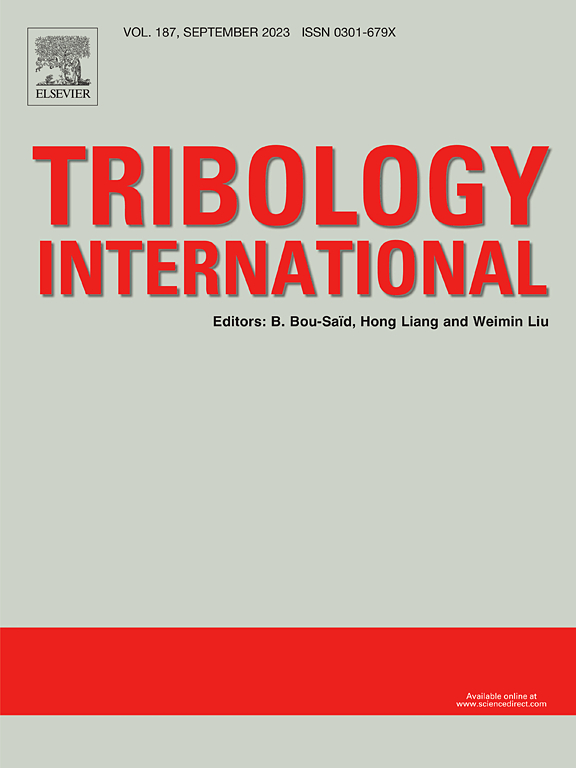功能化氢氮化硼和离子液体对pao基纳米润滑剂摩擦学性能和热稳定性的协同效应
IF 6.1
1区 工程技术
Q1 ENGINEERING, MECHANICAL
引用次数: 0
摘要
研究了以聚α -烯烃(PAO)为基础油,以原始六方氮化硼(BN)、功能化六方氮化硼(fBN)纳米片和阴离子液体(IL)为添加剂组成的新型杂化纳米润滑剂的摩擦学性能和热稳定性。采用XRD、HR-SEM、HR-TEM、FTIR和拉曼光谱对原始BN和fBN的微观结构和化学特征进行了表征。将浓度分别为0.05 wt%和0.1 wt%的BN和固定浓度为1 wt%的IL混合到PAO基础油中制备纳米润滑剂。摩擦学测试采用“球-盘”设置,热稳定性通过热重分析(TGA)进行评估。热稳定性显著提高,与纯PAO相比,起始降解温度提高了约33 %,完全分解温度提高了21 %。在PAO中含有0.1 wt% fBN和1 wt% IL的配方显示出最大的COF(约61 %)和磨损体积(约33 %)的减少。通过HR-SEM、EDX、3D光学轮廓术和拉曼光谱分析证实,性能的提高归因于接触界面上形成的摩擦膜。这项工作的新颖之处在于功能化BN纳米片与咪唑基IL在非极性PAO基础油中的协同集成,这在以前没有被探索过。这种混合配方大大提高了边界润滑下的摩擦减量和耐磨性,为开发先进的纳米润滑剂提供了一条有希望的途径,以提高能源效率和延长部件的耐久性。本文章由计算机程序翻译,如有差异,请以英文原文为准。
Synergistic effects of functionalized h-BN and ionic liquid on tribological performance and thermal stability of PAO-based nanolubricants
This study investigates the tribological properties and thermal stability of a novel hybrid nanolubricant composed of pristine hexagonal boron nitride (BN), functionalized hexagonal boron nitride (fBN) nanosheets, and anionic liquid (IL) as additives, with polyalphaolefin (PAO) as the base oil. The microstructural and chemical characteristics of pristine BN and fBN were characterized by XRD, HR-SEM, HR-TEM, FTIR, and Raman spectroscopy.Nanolubricants were prepared by blending of BN and fBN at 0.05 wt% and 0.1 wt% concentrations, and IL at a fixed 1 wt%, into PAO base oil. Tribological testing was conducted using a “ball-on-disc” setup, while thermal stability was assessed via thermo-gravimetric analysis (TGA). Thermal stability improved significantly, with the onset degradation temperature increasing by approximately 33 % and the complete decomposition temperature rising by 21 % compared to neat PAO. The formulation containing 0.1 wt% fBN and 1 wt% IL in PAO exhibited the maximum reduction in COF (approximately 61 %) and wear volume (approximately 33 %). The performance improvements are attributed to tribo-film formation at contact interfaces, confirmed by HR-SEM, EDX, 3D optical profilometry, and Raman spectroscopy. The novelty of this work lies in the synergistic integration of functionalized BN nanosheets with an imidazolium-based IL in a nonpolar PAO base oil, which has not been explored previously. This hybrid formulation substantially enhanced friction reduction and wear resistance under boundary lubrication, providing a promising pathway for developing advanced nanolubricants to improve energy efficiency and extend component durability.
求助全文
通过发布文献求助,成功后即可免费获取论文全文。
去求助
来源期刊

Tribology International
工程技术-工程:机械
CiteScore
10.10
自引率
16.10%
发文量
627
审稿时长
35 days
期刊介绍:
Tribology is the science of rubbing surfaces and contributes to every facet of our everyday life, from live cell friction to engine lubrication and seismology. As such tribology is truly multidisciplinary and this extraordinary breadth of scientific interest is reflected in the scope of Tribology International.
Tribology International seeks to publish original research papers of the highest scientific quality to provide an archival resource for scientists from all backgrounds. Written contributions are invited reporting experimental and modelling studies both in established areas of tribology and emerging fields. Scientific topics include the physics or chemistry of tribo-surfaces, bio-tribology, surface engineering and materials, contact mechanics, nano-tribology, lubricants and hydrodynamic lubrication.
 求助内容:
求助内容: 应助结果提醒方式:
应助结果提醒方式:


